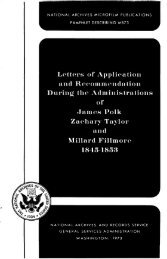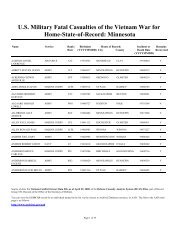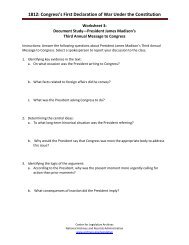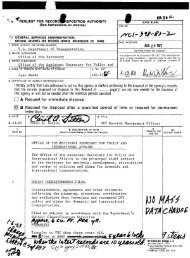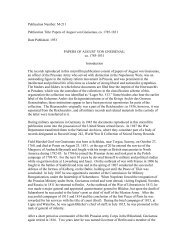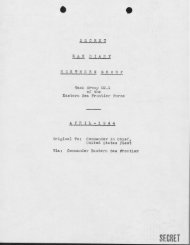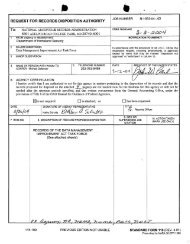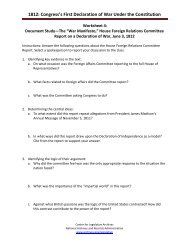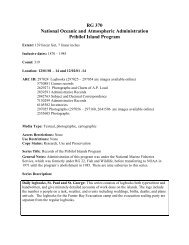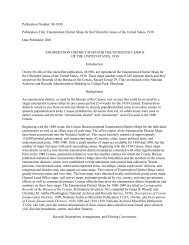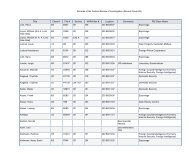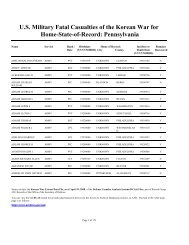HITLER'S SHADOW - National Archives and Records Administration
HITLER'S SHADOW - National Archives and Records Administration
HITLER'S SHADOW - National Archives and Records Administration
You also want an ePaper? Increase the reach of your titles
YUMPU automatically turns print PDFs into web optimized ePapers that Google loves.
to organize last ditch resistance. In mid-April 1945 Kaltenbrunner had ordered<br />
him <strong>and</strong> others to set up a network of SD <strong>and</strong> Gestapo agents <strong>and</strong> saboteurs<br />
to operate behind enemy lines at war’s end. 20 Around the same time, former<br />
Auschwitz Comm<strong>and</strong>ant Rudolf Höss also testified at Nuremberg. Höss noted<br />
that he had showed Mildner the entire camp including the gas chambers <strong>and</strong><br />
crematoria. Mildner was quite interested, Höss said, because he was deporting<br />
Jews from Katowice to Auschwitz. 21 It was a most damning account.<br />
In April 1946 the British requested Mildner’s extradition, probably because of<br />
the case of the executed British agent. CIC said it had no further interest in him <strong>and</strong><br />
did not object to extradition. A cryptic h<strong>and</strong>written note on the memo indicated<br />
that he was placed in Rogues Galley on May 4. 22 In June Danish intelligence wanted<br />
to pose more questions to Mildner about the case of Niels Bohr. How much did<br />
Nazi authorities know about Bohr, <strong>and</strong> why didn’t Mildner arrest him? The Danes<br />
sent a list of questions for American authorities to put to Mildner. But, according<br />
to CIC records, on August 11, 1946, Mildner escaped from Civilian Internment<br />
Camp #409 in Nuremberg. By the time Pol<strong>and</strong> also requested his extradition in<br />
December, his file indicates that his location was unknown. 23<br />
While in U.S. custody, Mildner described every branch <strong>and</strong> stem of Vienna’s<br />
Gestapo organization. A broad sample of other captured Vienna policemen also gave<br />
details to the Military Intelligence Research Service in Austria about their organization<br />
<strong>and</strong> their fellow officers. In November 1946 the Military Intelligence Service put out<br />
a 142-page report on the Gestapo in Vienna. Army Intelligence in Austria received<br />
11 copies; the 430th CIC detachment in Austria received 19 copies; the Office of U.S.<br />
Chief of Counsel (for War Crimes) received a single copy. Tracking <strong>and</strong> punishing<br />
war criminals were not high among the Army’s priorities in late 1946. 24<br />
One must infer why the U.S. Army put in such effort to reconstruct Gestapo<br />
organizational charts. Occupying parts of Germany <strong>and</strong> Austria, U.S. forces<br />
needed to keep order, <strong>and</strong> any diehard Nazi police forces represented a threat. On<br />
the other h<strong>and</strong>, more pragmatic German policemen who had dealt with security<br />
issues such as Communist espionage or subversion might have useful skills <strong>and</strong><br />
detailed knowledge. The Army initially seemed to consider Mildner one of the<br />
useful officials. Whether the CIC’s lenient treatment of Mildner contributed in<br />
some way to his ability to escape will remain unknown unless more information<br />
surfaces. There is one suggestive source: Nuremberg psychiatrist Leon Goldensohn<br />
believed Mildner remained in American custody until 1949. 25 It is possible that<br />
New Materials on Former Gestapo Officers | 39



